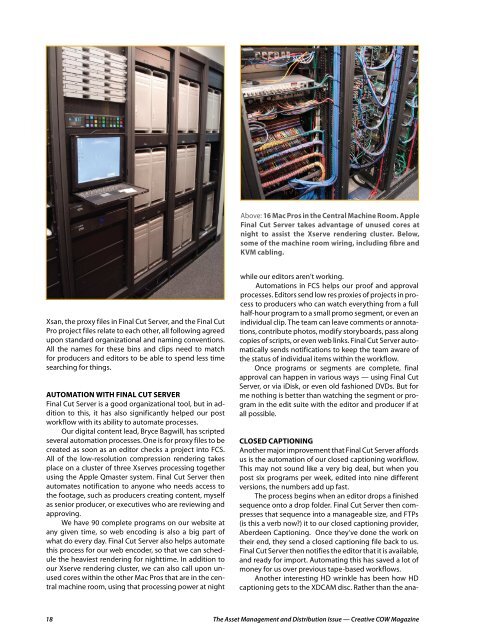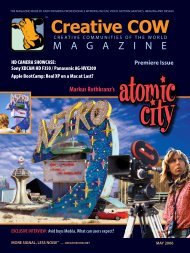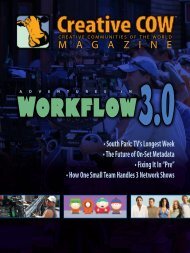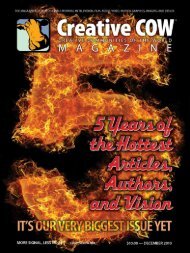Read the COW Magazine Online - Creative COW Magazine
Read the COW Magazine Online - Creative COW Magazine
Read the COW Magazine Online - Creative COW Magazine
Create successful ePaper yourself
Turn your PDF publications into a flip-book with our unique Google optimized e-Paper software.
Xsan, <strong>the</strong> proxy files in Final Cut Server, and <strong>the</strong> Final Cut<br />
Pro project files relate to each o<strong>the</strong>r, all following agreed<br />
upon standard organizational and naming conventions.<br />
All <strong>the</strong> names for <strong>the</strong>se bins and clips need to match<br />
for producers and editors to be able to spend less time<br />
searching for things.<br />
AUTOMATION WITH FINAL CUT SERVER<br />
Final Cut Server is a good organizational tool, but in addition<br />
to this, it has also significantly helped our post<br />
workflow with its ability to automate processes.<br />
Our digital content lead, Bryce Bagwill, has scripted<br />
several automation processes. One is for proxy files to be<br />
created as soon as an editor checks a project into FCS.<br />
All of <strong>the</strong> low-resolution compression rendering takes<br />
place on a cluster of three Xserves processing toge<strong>the</strong>r<br />
using <strong>the</strong> Apple Qmaster system. Final Cut Server <strong>the</strong>n<br />
automates notification to anyone who needs access to<br />
<strong>the</strong> footage, such as producers creating content, myself<br />
as senior producer, or executives who are reviewing and<br />
approving.<br />
We have 90 complete programs on our website at<br />
any given time, so web encoding is also a big part of<br />
what do every day. Final Cut Server also helps automate<br />
this process for our web encoder, so that we can schedule<br />
<strong>the</strong> heaviest rendering for nighttime. In addition to<br />
our Xserve rendering cluster, we can also call upon unused<br />
cores within <strong>the</strong> o<strong>the</strong>r Mac Pros that are in <strong>the</strong> central<br />
machine room, using that processing power at night<br />
Above: 16 Mac Pros in <strong>the</strong> Central Machine Room. Apple<br />
Final Cut Server takes advantage of unused cores at<br />
night to assist <strong>the</strong> Xserve rendering cluster. Below,<br />
some of <strong>the</strong> machine room wiring, including fibre and<br />
KVM cabling.<br />
while our editors aren’t working.<br />
Automations in FCS helps our proof and approval<br />
processes. Editors send low res proxies of projects in process<br />
to producers who can watch everything from a full<br />
half-hour program to a small promo segment, or even an<br />
individual clip. The team can leave comments or annotations,<br />
contribute photos, modify storyboards, pass along<br />
copies of scripts, or even web links. Final Cut Server automatically<br />
sends notifications to keep <strong>the</strong> team aware of<br />
<strong>the</strong> status of individual items within <strong>the</strong> workflow.<br />
Once programs or segments are complete, final<br />
approval can happen in various ways — using Final Cut<br />
Server, or via iDisk, or even old fashioned DVDs. But for<br />
me nothing is better than watching <strong>the</strong> segment or program<br />
in <strong>the</strong> edit suite with <strong>the</strong> editor and producer if at<br />
all possible.<br />
CLOSED CAPTIONING<br />
Ano<strong>the</strong>r major improvement that Final Cut Server affords<br />
us is <strong>the</strong> automation of our closed captioning workflow.<br />
This may not sound like a very big deal, but when you<br />
post six programs per week, edited into nine different<br />
versions, <strong>the</strong> numbers add up fast.<br />
The process begins when an editor drops a finished<br />
sequence onto a drop folder. Final Cut Server <strong>the</strong>n compresses<br />
that sequence into a manageable size, and FTPs<br />
(is this a verb now?) it to our closed captioning provider,<br />
Aberdeen Captioning. Once <strong>the</strong>y’ve done <strong>the</strong> work on<br />
<strong>the</strong>ir end, <strong>the</strong>y send a closed captioning file back to us.<br />
Final Cut Server <strong>the</strong>n notifies <strong>the</strong> editor that it is available,<br />
and ready for import. Automating this has saved a lot of<br />
money for us over previous tape-based workflows.<br />
Ano<strong>the</strong>r interesting HD wrinkle has been how HD<br />
captioning gets to <strong>the</strong> XDCAM disc. Ra<strong>the</strong>r than <strong>the</strong> ana-<br />
log “Line 21” (EIA-608) transport, <strong>the</strong> CEA-708 standard<br />
embeds <strong>the</strong> captioning straight into <strong>the</strong> HD-SDI stream<br />
for recording, whe<strong>the</strong>r to tape, or in our case, back to XD-<br />
CAM disc.<br />
DUPLICATION AND DISTRIBUTION<br />
Once a program is mastered to disc, our in-house duplication<br />
department makes <strong>the</strong> air dubs and ships <strong>the</strong>m<br />
out. It seems we send out tapes in every known format<br />
to meet all <strong>the</strong> different network and station requirements.<br />
With HD, this has only become more complicated.<br />
Currently only a handful of networks we work with accept<br />
high definition masters, and even in that small<br />
group, <strong>the</strong>re are many different formats required. Because<br />
of this, Up/Down/Cross conversion of our media<br />
has become an important part of what our duplication<br />
team does. AJA FS-1 and Link HDC-925 up/down/cross<br />
converters play a vital role in <strong>the</strong> central machine room.<br />
O<strong>the</strong>r than <strong>the</strong> handful of stations airing direct from<br />
DVD, everything we deliver is on tape. We are in preliminary<br />
discussions with a couple of networks on FTP distribution.<br />
However those talks are only in <strong>the</strong> investigative<br />
stages. Over 100 radio stations are already connecting to<br />
our FTP to download weekly programs which has been<br />
very successful. We have a high interest in doing this with<br />
television as well, and using Final Cut Server.<br />
SCRATCHING THE SURFACE<br />
At Joyce Meyer Ministries, everything we do is done in an<br />
atmosphere of collaboration and teamwork. In that spirit,<br />
as a broadcast team, we feel that we are only scratching<br />
<strong>the</strong> surface of what we can eventually build with digital<br />
asset management and a file-based workflow.<br />
Going forward, we recognize and understand <strong>the</strong><br />
media we create will not only help to preserve <strong>the</strong> legacy<br />
of <strong>the</strong> ministry, but will also help build its future. As new<br />
technologies continue to emerge, we hope to discover<br />
even better ways to use a data centric workflow to enhance<br />
our media and broadcast team’s ability to collaborate,<br />
gain increased efficiencies and reduce cost.<br />
As a nonprofit, throughout <strong>the</strong> ministry, we are extremely<br />
conscious of stewardship issues and strive to<br />
maintain <strong>the</strong> highest quality, both creatively and technically,<br />
while also being good stewards of both donations<br />
and resources by keeping costs and expenses as low as<br />
possible. Any time we can increase efficiencies or reduce<br />
costs using technology automation means allows those<br />
critical resources to be used to feed, house or help one<br />
more person —and, for all of us at JMM, that is what it is<br />
all about.<br />
n<br />
18 The Asset Management and Distribution Issue — <strong>Creative</strong> <strong>COW</strong> <strong>Magazine</strong><br />
<strong>Creative</strong> <strong>COW</strong> <strong>Magazine</strong> — The Asset Management and Distribution Issue 19










